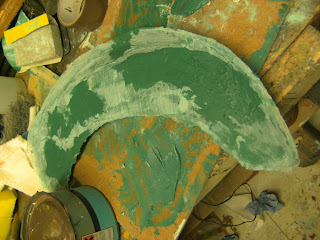Laminating in the moulds again
The last post
This post finished with a picture of the insert to extend the rear of the cockpit in its early stages.
After just a few brush strokes (with a foam brush) it does this, and all you can do is keep moving it around until it begins to thicken through evaporation (the process is quicker in the warm).
This post finished with a picture of the insert to extend the rear of the cockpit in its early stages.
Installed it looked like this, a bit rough - the idea being to fair the prototype first kayak.
Adding the PVA release agent
Before the polyvinyl alcohol release agent was applied, the two halves of the mould were polished with Mirrorglaze release wax three times. Now for the tricky bit - the PVA release agent which is dissolved in alcohol, and also apparently contains some water content beads badly on wax.After just a few brush strokes (with a foam brush) it does this, and all you can do is keep moving it around until it begins to thicken through evaporation (the process is quicker in the warm).
As new parts of the surface are coated and the area under the release agent increases, one keeps going back to the parts coated earlier and so on until eventually you end up with an even non beaded coating in some areas and not in others
until eventually it all comes good, but it takes some time!
The inserts for hatch covers were added afterwards. All this took at least a couple of hours.
Laminating the two halves
First of all I gave the workshop a good clean and tidy, cleared the work areas put everything in what seemed the right place, cut the fabric to shape (by wrapping round the outside of the mould and cutting where the fabric meets the flange). The hull has a layer of 450gsm chopped strand matt followed by a layer of 300gsm woven rovings. The deck is pieced together from the offcuts, with a complete centre section added for strength where you need it round the cockpit and foredeck.
I used 1.4 kg of gelcoat on the hull and about the same on the deck and it was not really as much as I would have liked (1.5 would have been about right), also I was really rushed to finish application properly as it was beginning to gel at the end; 2% catalyst was too much on a hot day.
Here are the notes I wrote whilst recovering in between sessions with a cup of tea - and in clean air:-
Acetone dissolves nitrile gloves - use washing up gloves for cleaning brushes i.e. large over nitrile.
Need an extractor!!!
2 kg for laminating deck 2.5 for hull
The Kevlar shears were invaluable throughout the process
Find a better brush cleaning system
Find a better system for dispensing resin (the resin comes in a 20kg tub, so one has to use a cup or something similar as a scoop, with all the resulting mess)
Remove excessive gelcoat from the flange after finishing - and before it sets very hard
The resin wetted out really well
Dispose rather than try to clean rollers
Use less than 1% catalyst on a warm day for laminating
Stick keel stiffener to laminate first and then glass over it
gelcoated halves
laminated deck
Hull with stiffener. The next post will describe how the two halves are joined together and then popped out of the mould.











Comments
Post a Comment